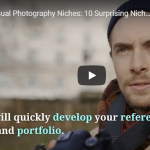SEO for photography? How important are Google rankings?
At its most basic, Google Search results are popularity contests. If people like your website and connect to it, you are all set up. If they do not, then you will have to sit in the cafeteria by yourself.
Google’s famous PageRank algorithm (named after co-founder Larry Page) moves web pages up in search rankings when certain pages redirect to them.
It is pretty much as basic as that. The more pages you link to, the quicker Google thinks your page is, and the higher you will notice yourself in the search engine results.

This portion of the SEO for photography guide will focus on how to get those links from many other pages, called backlinks, so that that your own photography website will rank up in Google’s search results for the keywords you have targeted. Part 1 of this SEO for Photography Guide discussed how to identify relevant, workable keywords for your website clearly, and Part 2 discussed changes that you can make to your page to help rank certain keywords.
Building backlinks is a lot tougher than on-page SEO, but it is impossible to get ranked without it. According to some research, backlinks account for almost 50 percent of search engine rankings.
Not All Links Were Created Equal
Google ranks every web page on a 0-10 scale, and the higher it’s rated, the better you get a link from it. For example, a link from CNN.com (page 9) to your photography website is much better than a lower-ranking site.
Of course, it is also a lot harder to get a link from these kinds of sites, and you could rank rather well without it.
Start Simply
There are hundreds of photographer directories on the internet, each to provide a link to photographers. Links from directories like this do not carry a lot of juice, but if you are just starting up, every bit matters.
- www.photographysites.com
- photographersindex.com
- www.photographers.com
- www.photographypros.com
Still, check out local photo affiliations and local business directories in your location, such as your local Better Business Bureau website.
Use Flickr
It may be challenging to get people to come to your photography website, but Flickr has got you covered. Posting your best images to Flickr is a wonderful way to get attention, and you could include a link back to your website in your image description, thus improving your SEO for photography.
Vary the text around the link so often, so Google does not think it is just duplicate content. See The Ultimate Guide to Becoming Popular on Flickr for more on making the most of Flickr.
Participate in Online Photography Communities
A great way to get to know people who can add links to your site is to take part in photography forums. Adding to the discussion improves your track record in the photography community, and it may bring you to the exposure of photographers who manage their own websites.
Most of the forums let you add a signature to your posts. When they do, make sure that yours contains a link back to your website.

Another wonderful way to take part in the photographic community, and to create backlinks at the same time, is to post on blogs. Adding insightful comments is a great way to build a network of online photographer friends, and as in a forum, you can normally have a link to your own website in a comment signature.
Write a Blog
As we have seen in the second phase of this SEO for Photography Guide, photographers need to write a lot if they really want to improve their rankings. Part of this is starting a blog. This may seem like a lot of work and a major problem, but it is a great way to boost your rankings when you choose your subjects carefully.
A blog is not meant to be a person rambling about a subject that springs to mind. Your photoblog should include an emphasis on topics related to the keywords you are targeting. If you are a sporting events photographer, write about how you covered a local game, including several of your photos, and the links to your portfolio. Google rewards new content, and the original content with links to your website will make wonderful things about your SEO for photography.
Guest Blogging
Once you have got your blogging knowledge in order, you could consider writing guest blog posts to other sites. If you have been making comments on blog posts as I suggested, then you should have a pretty good idea of what blogs would be most applicable to you.
Craft an email to the blog owner and offer to write a blog post on a topic that is applicable to both you and the audience of the blog. Writing an unsolicited email like this may seem annoying, but do not worry about it. Blog writers are often looking for new content, and if you could make their workload simpler, they are likely to take you on board. In your email, be certain to have a link to your own blog, so the person you are writing can check that you are a professional writer with great subject awareness.
Facebook Fan Pages
Every photographer needs a fan page on Facebook. They are free and easy to set up. Once you have made one, be sure to post your photos daily, so people who find your page can “like” your work. This will likewise improve your SEO for photography.

Whenever you post a blog post, please share it on Facebook. Facebook links may not get you a lot of link juice from Google, but it’s a good way to get exposure, and people who find your fan page can blog about it.
Summing Up SEO for Photography Part 3
This is to summarize the third instalment of our SEO for Photography Guide. I know it sounds like a lot of work, but the outcomes can be incredible, especially when you eventually get to work because someone has found your website. Soon, your search engine rankings may become a significant source of potential new clients.
If you are curious to read more online, I highly recommend the SEO Book of Photographers which is dedicated to teaching SEO for photography – and they really know their business!
Another important part of any photography is to protect your online photos from theft. Unlimited watermarks are available with Watermarquee‘s pro version, so start watermarking today.

































